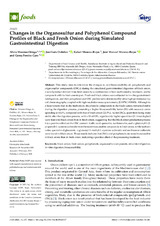Changes in the Organosulfur and Polyphenol Compound Profiles of Black and Fresh Onion during Simulated Gastrointestinal Digestion
Autor
Moreno Ortega, Alicia
Ordóñez, José Luis
Moreno Rojas, Rafael
Moreno-Rojas, José Manuel
Pereira-Caro, Gema
Editor
MDPIFecha
2021Materia
Black onionFresh onion
Polyphenols
Organosulfur compounds
Simulated digestion
In-vitro digestion
Bioaccessibility
METS:
Mostrar el registro METSPREMIS:
Mostrar el registro PREMISMetadatos
Mostrar el registro completo del ítemResumen
This study aims to determine the changes in, and bioaccessibility of, polyphenols and organosulfur compounds (OSCs) during the simulated gastrointestinal digestion of black onion, a novel product derived from fresh onion by a combination of heat and humidity treatment, and to compare it with its fresh counterpart. Fresh and black onions were subjected to in-vitro gastrointestinal digestion, and their polyphenol and OSC profiles were determined by ultra-high-performance liquid chromatography coupled with high-resolution mass spectrometry (UHPLC-HRMS). Although to a lesser extent than in the fresh onion, the phenolic compounds in the black variety remained stable during the digestion process, presenting a higher bioaccessibility index (BI) with recovery corresponding to 41.1%, compared with that of fresh onion (23.5%). As for OSCs, apart from being more stable after the digestion process, with a BI of 83%, significantly higher quantities (21 times higher) were found in black onion than in fresh onion, suggesting that the black onion production process has a positive effect on the OSC content. Gallic acid, quercetin, isorhamnetin, and ɣ-glutamyl-S-(1-propenyl)-L-cysteine sulfoxide were the most bioaccessible compounds in fresh onion, while isorhamnetin, quercetin-diglucoside, ɣ-glutamyl-S-methyl-L-cysteine sulfoxide and methionine sulfoxide were found in black onion. These results indicate that OSCs and polyphenols are more bioaccessible in black onion than in fresh onion, indicating a positive effect of the processing treatment.

